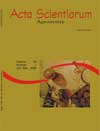<b>Effect of type and harvest period on coffee quality (<em>Coffea arabica</em> L.)</b> - DOI: 10.4025/actasciagron.v25i1.2464
Abstract
Coffee (Coffea arabica L.) of Catuaí vermelho cultivar was harvested in the region of Lavras, state of Minas Gerais, Brazil, in seven different periods. Harvest periods were 14 days apart, the first one was performed on 31/5/1999 and the seventh harvest was accomplished on 25/8/1999. In each period, 480 liters of fruits were taken from 250 plants (cloth coffee) in a same planting field that contained 1750 plants. Also, the harvest of fruits fallen on ground (ground coffee) was accomplished. These fruits were put to dry on cement flat open terraces until the beans reach moisture content of 11 to 13%. Soon afterwards, 3 samples were taken for the undertaking of analysis. The drop of plant fruits increased with the harvest delay. In the cloth coffee, there was increase in the activity of polyphenol oxidase enzyme and decrease in contents of total phenolics and chlorogenic acid, showing better quality. As for the coffee collected from the ground, despite presenting different values, showed a variation similar to the cloth coffee. Comparing the values of different constituents in cloth coffee to ground coffee in the different harvest periods, the cloth coffee presented higher contents of total phenolics and chlorogenic acid and high activity of polyphenol oxidase. The evaluation of beverage quality classified the coffee, in all harvest periods, as hard beverage.Downloads
Download data is not yet available.
Published
2008-04-23
How to Cite
Pimenta, C. J., & Vilela, E. R. (2008). <b>Effect of type and harvest period on coffee quality (<em>Coffea arabica</em> L.)</b> - DOI: 10.4025/actasciagron.v25i1.2464. Acta Scientiarum. Agronomy, 25(1), 131-136. https://doi.org/10.4025/actasciagron.v25i1.2464
Issue
Section
Agronomy
DECLARATION OF ORIGINALITY AND COPYRIGHTS
I Declare that current article is original and has not been submitted for publication, in part or in whole, to any other national or international journal.
The copyrights belong exclusively to the authors. Published content is licensed under Creative Commons Attribution 4.0 (CC BY 4.0) guidelines, which allows sharing (copy and distribution of the material in any medium or format) and adaptation (remix, transform, and build upon the material) for any purpose, even commercially, under the terms of attribution.
2.0
2019CiteScore
60th percentile
Powered by 

2.0
2019CiteScore
60th percentile
Powered by 



















































